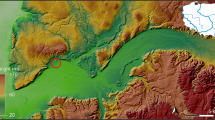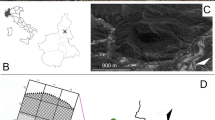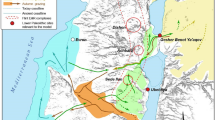Abstract
The beginning of relationships between autochthonous communities and Phoenicians from the earliest contacts in the eighth century BC made possible the exchange of ideas, technologies and people. This work analyses the development of the Early Iron Age potteries of the Iberian Southeast, the impact of the Phoenician presence and the agency that these local groups exercised on their ceramic assemblages until the fifth century BC. The incorporation of new archaeometric data from Castellar de Librilla, one of the region’s main autochthonous settlements, has been essential to improve our approach to these cultural encounters. A total of 63 representative individuals have been analysed through X‐ray fluorescence (XRF), X‐ray diffraction (XRD), thin-section petrography and scanning electron microscopy (SEM). The results point to the local production of ceramics previously considered as Western Phoenician pottery, and to the degree of specialisation of the potters established in the autochthonous settlements, combining traditional and new techniques from early in the period of contact.











Similar content being viewed by others
Data availability
All data needed to elaborate this work and its conclusions are present in the paper. Additional data related to this paper may be requested from the authors.
References
Aitchison J (1986) The statistical analysis of compositional data. Chapman and Hall, London
Albero D, Cau MA (2016) Technological choices in handmade indigenous pottery from Western Mallorca (Balearic Islands, Spain) (c. 1200-75 BC): an archaeometric approach. Archaeometry 59(4):1–25. https://doi.org/10.1111/arc.12273
Amadori ML, Baldassari R, Lanza S, Maione M, Penna A, Acquaro E (2002) Archaeometric study of Punic amphorae from the underwater recoveries of Pantelleria Island (Sicily). Rev Archéométrie 26:79–91. https://doi.org/10.3406/arsci.2002.1025
Anderson WP (1987) The kilns and workshops of Sarepta (Sarafand, Lebanon): remnants of a Phoenician ceramic industry. Berytus 35:41–66
Arancibia A, Escalante MM (2006) La Málaga fenicio-púnica a la luz de los últimos hallazgos. Mainake 28:333–360
Argus DF, Gordon RG, DeMets C (2011) Geologically current motion of 56 plates relative to the no-net-rotation reference frame. Geochem Geophys Geosyst 12(11):1–13. https://doi.org/10.1029/2011GC003751
Arteaga O, Serna A (1975) Los Saladares-71. Noticiario Arqueológico Hispánico 3:7–140
Aubet ME, Carmona P, Curià E, Delgado A, Fernández A, Párraga M (1999) Cerro del Villar I. El asentamiento fenicio en la desembocadura del río Guadalhorce y su interacción con el hinterland. Junta de Andalucía, Sevilla
Bhabha HK (1994) The Location of Culture. Routledge, New York
Buxeda i Garrigós J (1999) Alteration and contamination of archaeological ceramics: the perturbation problem. J Archaeol Sci 26:295–313
Buxeda i Garrigós J (2018) Compositional data analysis. In: López Varela SL (ed) The encyclopedia of archaeological sciences. Wiley, Oxford, pp 1–5
Buxeda i Garrigós J, Cau MA (1995) Identificación y significado de la calcita secundaria en cerámicas arqueológicas. Complutum 6:293–309
Buxeda i Garrigós J, Cau MA, Madrid M, Toniolo A (2005) Roman amphorae from the Iulia Felix Shipwreck: alteration and provenance. In: Hars H, Burke E (eds) Proceedings of the 33rd International Symposium on Archaeometry, 22–26 April 2002, Amsterdam. Institute for Geo- and Bioarchaeology of the Vrije Universiteit in Amsterdam, Amsterdam, pp 149–151.
Buxeda i Garrigós J, Kilikoglou V (2003) Total variation as a measure of variability in chemical data sets. In: Zelst LV (ed) Patterns and process. A festschrift in honor of Dr. Edward V. Sayre. Smithsonian Center for Materials Research and Education, Maryland, pp 185–198.
Buxeda i Garrigós J, Kilikoglou V, Day PM (2001) Chemical and mineralogical alterations of ceramics from a Late Bronze Age kiln at Kommos, Crete: the effect on the formation of a reference group. Archaeometry 43:349–371. https://doi.org/10.1111/1475-4754.00021
Buxeda i Garrigós J, Madrid M (2017) Designing rigorous research: integrating science and archaeology. In: Hunt A (ed) The Oxford handbook of archaeological ceramic analysis. Oxford University Press, Oxford, pp 19–47
Buxeda i Garrigós J, Mommsen H, Tsolakidou A (2002) Alterations of Na, K and Rb concentrations in Mycenaean pottery and a proposed explanation using X-ray diffraction. Archaeometry 44(2):187–198. https://doi.org/10.1111/1475-4754.t01-1-00052
Calmel-Ávila A (2000) Procesos hídricos holocenos en el Bajo Guadalentín (Murcia, España). Cuaternario y Geomorfología 14(3):65–78
Carrión JS, Fernández S, Jiménez-Moreno G, Fauquette S, Gil-Romera G, González-Sampériz P, Finlayson C (2010) The historical origins of aridity and vegetation degradation in southeastern Spain. J Arid Environ 74(7):731–736. https://doi.org/10.1016/j.jaridenv.2008.11.014
Cau MA, Day PM, Montana G (2002) Secondary calcite in archaeological ceramics: evaluation of alteration and contamination processes by thin section study. In: Kilikoglou V, Maniatis Y, Hein A (eds) Modern trends in ancient ceramics. British Archaeological Reports International Series 1011, Oxford, pp 9–18.
Cau MA, Fantuzzi L, Albero D, Tsantini E, García Roselló J, Calvo M (2019) Archaeometric characterisation of Iron Age indigenous pottery from the staggered turriform of Son Ferrer, Mallorca, Spain. Geoarchaeology 34:149–168. https://doi.org/10.1002/gea.21696
Contreras F, Carrión F, Jabaloy EM (1983) Un horno de alfarero protohistórico en el cerro de los Infantes (Pinos Puente, Granada). XVI Congreso Nacional de Arqueología. Univ. de Zaragoza, Zaragoza, pp 533–538
Cuevas J, Ruiz AI, Fernández R, González-Santamaría D, Angulo M, Ortega A, Torres E, Turrero MJ (2018) Authigenic clay minerals from interface reactions of concrete-clay engineered barriers: a new perspective on Mg-clays formation in alkaline environments. Minerals 8(362):1–18. https://doi.org/10.3390/min8090362
Cutillas B (2019) El ajuar cerámico de una unidad rural del Hierro Antiguo: el caso de La Torre de Sancho Manuel (Lorca, R. de Murcia). In: Coll J (ed) Opera Fictiles. Estudios transversales sobre cerámicas antiguas de la península ibérica. SECAH-La Ergástula, Valencia, pp 11–26.
Cutillas B, Ros MM (2020) Asentamientos polinucleares y resiliencia urbana entre el Bronce Final y la Edad del Hierro en el Sureste ibérico: nuevos datos a partir del Castellar de Librilla. Complutum 31(1):71–96. https://doi.org/10.5209/cmpl.71650
Delgado A (2010) De las cocinas coloniales y otras historias silenciadas: domesticidad, subalternidad e hibridación en las colonias fenicias occidentales. In: Mata C, Pérez G, Vives-Ferrándiz J (eds) De la Cuina a la Taula. IV Reunió d’Economia en el Primer Millenni a.C. Sagvntvm Extra 9, Valencia, pp 27–42.
Dothan M (1989) Archaeological evidence for movements of the early “Sea Peoples” in Canaan. In: Gitin S, Dever WG (eds) Recent excavations in Israel: studies in Iron Age archaeology. Eisenbrauns, Winona Lake, pp 59–70.
Egozcue JJ, Pawlowsky-Glahn V (2011) Basic concepts and procedures. In: Pawlowsky-Glahn V, Buccianti A (eds.) Compositional data analysis. Theory and Applications. Wiley, Chichester, pp 12–28.
Fernández A, Rodríguez A (2007) Tartessos desvelado. La colonización fenicia del Suroeste peninsular y el origen y ocaso de Tartessos. Almuzara, Córdoba.
Forjanes P, Astilleros JM, Fernández-Díaz L (2020) The formation of barite and celestite through the replacement of gypsum. Minerals 10(189):1–17. https://doi.org/10.3390/min10020189
García Blánquez LA (1996) El Cerro de la Fuente del Murtal, Alhama de Murcia (1ª campaña 1991): poblado fortificado del período de transición Bronce Final / Hierro Antiguo en el eje de poblamiento Segura-Guadalentín (Murcia). Memorias de Arqueología de la Región de Murcia 5:65–85
García Menárguez A, Prados F (2014) La presencia fenicia en la Península Ibérica: el Cabezo Pequeño del Estaño (Guardamar del Segura, Alicante). Trab Prehist 71(1):113–133. https://doi.org/10.3989/tp.2014.12127
Gliozzo E (2020) Ceramic technology. How to reconstruct the firing process. Archaeol Anthropol Sci 12:1–24. https://doi.org/10.1007/s12520-020-01132-z
González Prats A (1983) Estudio Arqueológico del poblamiento antiguo de la Sierra de Crevillente (Alicante). Univ. de Alicante, Alicante
González Prats A (2011) La Fonteta. Excavaciones de 1996–2002 en la colonia fenicia de la actual desembocadura del río Segura (Guardamar del Segura, Alicante). Univ. de Alicante, Alicante
González Prats A, Pina JA (1983) Análisis de las pastas cerámicas de vasos hechos a torno de la fase orientalizante de Peña Negra (675–550/535 a.C.). Lucentum 2:115–146. https://doi.org/10.14198/lucentum1983.2.06
Heimann RB, Maggetti M (2014) Ancient and historical ceramics. Materials, technology, art, and culinary traditions. Schweizerbart Science Publishers, Stuttgart
Herrero P, Álvarez JA, Martínez JJ (2017) Análisis estructural en el segmento Alhama de Murcia - Alcantarilla (Falla de Alhama de Murcia) y sus implicaciones en la peligrosidad sísmica. Geogaceta 62:11–14
Hodder I (2012) Entangled: an archaeology of the relationships between humans and things. Wiley-Blackwell, Malden
Ingold T (2001) Beyond art and technology: the anthropology of skill. In: Schiffer MB (ed) Anthropological perspectives on technology. University of New Mexico Press, Albuquerque, pp 17–31
Kampschuur W, Langeberg CW, Montenat CH, Pignatelli R, Egeler CG (1972) Mapa Geológico de España. Escala 1:50.000 hoja 933 (Alcantarilla). IGME. Madrid
Lemoine C, Poupet P, Barrandon JN, Borderie B, Meille E (1981) Étude de quelques altérations de composition chimique des céramiques en milieu marin et Terrestre. Rev Archéométrie 1:349–360. https://doi.org/10.3406/arsci.1981.1166
Lomba J, Cano M (2002) El Cabezo de la Fuente del Murtal (Alhama): Definición e interpretación de una fortificación de finales del siglo VII a.C. e inicios del VI en la rambla de Algeciras (Alhama de Murcia, Murcia). Memorias de Arqueología de la Región de Murcia 11:165–204
Lorrio A, Pernas S, Torres M (2016) Puntas de flecha orientalizantes en contextos urbanos del Sureste de la Península Ibérica: Peña Negra, La Fonteta y Meca. CuPAUAM 42:9–78. https://doi.org/10.15366/cupauam2016.42.001
Manteca JI, Pérez MA, López MA (2005) La Industria Minera en Murcia durante la época contemporánea. Bocamina 15:123–136
Martín-Fernández JA, Buxeda i Garrigós J, Pawlowsky-Glahn V (2015) Logratio analysis in archaeometry: principles and methods. In: Barceló JA, Bogdanovic I (eds) Mathematics and archaeology. CRC Press, Boca Ratón, pp 178–189
Martínez M (2006) Excavación arqueológica en la zona de La Alberca (Lorca, Murcia). Un horno alfarero de los siglos VII-VI a.C. y un centro comercial y militar de época tardopúnica y romana. Memorias de Arqueología de la Región de Murcia 14:213–260
Molinos M, Rísquez C, Serrano JL, Montilla S (1994) Un problema de fronteras en la periferia de Tartessos: Las Calañas de Marmolejo (Jaén). Univ. de Jaén, Jaén
Morales ML, López G, López A (2019) El yacimiento de azufre de La Serrata, Lorca, Murcia. Paragénesis 2:47–58
Navarro F, Ros MM, Rodríguez T, García J, Fierro E, Carrión J, Flores JA, Bárcenas MA, García MS (2014) Evaporite evidence of a mid-Holocene (c. 4550–4400 cal. BP) aridity crisis in southwestern Europe and palaeoenvironmental consequences. Holocene 24:489–205. https://doi.org/10.1177/0959683613520260
Nijboer AJ, van der Plicht J (2006) An interpretation of the radiocarbon determinations of the oldest indigenous-Phoenician stratum thus far, excavated at Huelva, Tartessos (south-west Spain). Bulletin Des Antieke Beschaaving 81:31–36. https://doi.org/10.2143/BAB.81.0.2014423
Palmer SJ, Spratt HJ, Frost RL (2009) Thermal decomposition of hydrotalcites with variable cationic ratios. J Therm Anal Calorim 95(1):123–129. https://doi.org/10.1007/s10973-008-8992-4
Picon M (1973) Introduction à l’étude technique des céramiques sigillées de Lezoux. Unversité de Dijon, Dijon
Picon M (1987) La fixation du baryum et du strontium par les céramiques. Rev Archéométrie 11:41–47. https://doi.org/10.3406/arsci.1987.1236
Picon M (1991) Quelques observations complémentaires sur les altérations de composition des céramiques au cours du temps: cas de quelques alcalins et alcalino-terreux. Rev Archéométrie 15:117–122. https://doi.org/10.3406/arsci.1991.1263
Pradell T, Vendrell-Saz M, Krumbein W, Picon M (1996) Altérations de céramiques en millieu marin: les amphores de l’épave romaine de la Madrague de Giens (Var). Rev Archéométrie 20:47–56. https://doi.org/10.3406/arsci.1996.936
Prieto M, Fernandez-Gonzalez A, Putnis A, Fernandez-Diaz L (1997) Nucleation, growth, and zoning phenomena in crystallizing (Ba, Sr)CO3, Ba(SO4, CrO4), (Ba, Sr)SO4, and (Cd, Ca)CO3 solid solutions from aqueous solutions. Geochim Cosmochim Acta 61(16):3383–3397. https://doi.org/10.1016/S0016-7037(97)00160-9
Quinn P (2013) Ceramic petrography. The interpretation of archaeological pottery and related artefacts in thin section. Archaeopress, Oxford
R Core Team (2021) R: a language and environment for statistical computing. R Foundation for Statistical Computing, Vienna. http://www.R-project.org/
Roberts J (1963) Determination of the firing temperature of ancient ceramics by measurement of thermal expansion. Archaeometry 6:21–25. https://doi.org/10.1111/j.1475-4754.1969.tb00636.x
Ros MM (1986–1987) El poblado de Santa Catalina del Monte: una aproximación a la urbanística del siglo VI a.C. en el ámbito territorial del eje Segura-Guadalentín. Cuadernos de Prehistoria y Arqueología 13–14:77–88
Ros MM (1989) Dinámica urbanística y cultura material del Hierro Antiguo en el Valle del Guadalentín. Univ. de Murcia, Murcia
Ros MM (2017) Nuevos datos en torno a la presencia fenicia en la Bahía de Mazarrón (Sureste Ibérico). In: Prados F, Sala F (eds) El Oriente de Occidente. Fenicios y púnicos en el área ibérica. Univ. de Alicante, Alicante, pp 79–104
Rouillard P, Gailledrat E, Sala F (2007) L’établissement protohistorique de La Fonteta (fin VIIIe – VIe siècle av. J.-C.). Casa de Velázquez, Madrid.
Roux V, Corbetta D (1989) Wheel-throwing technique and craft specialisation. In: Roux V (ed) The ‘Potter’s wheel. Oxford - IBH Publishing, New Delhi, Craft specialisation and technical competence, pp 1–91
Sánchez V, Galindo L, Juzgado M, Dumas M (2011) La desembocadura del Guadalhorce en los siglos IX y VIII a.C. y su relación con el Mediterráneo. In: Domínguez JC (ed) Gadir y el círculo del Estrecho revisados. Propuestas de la arqueología desde un enfoque social. Univ. de Cádiz, Cádiz, pp 187–197
Schwedt A, Mommsen H, Zacharias N, Buxeda i Garrigós J (2006) Analcime crystallisation and compositional profiles—comparing approaches to detect post-depositional alterations in archaeological pottery. Archaeometry 48(2):237–251. https://doi.org/10.1111/j.1475-4754.2006.00254.x
Schiffer M (2010) Behavioral archaeology. Principles and practice. Equinox, London-Oakville
Tite MS, Maniatis Y, Meeks ND, Bimson M, Hughes MJ, Leppard SC (1982) Technological studies of ancient ceramics from the Near East, Aegean and Southeast Europe. In: Wertime TA, Wertime SF (eds) The evolution of the first fire-using industries. Smithsonian Institution Press, Washington, pp 61–71
van de Boogaart KG, Tolosana-Delgado R (2013) Analysing compositional data with R. Springer-Verlag, Berlin
van Dommelen P (1998) On colonial grounds: a comparative study of colonialism and rural settlement in first millennium BC west central Sardinia. University of Leiden, Leiden
Whitbread IK (1989) A proposal for the systematic description of thin sections towards the study of ancient technology. In: Maniatis Y (ed) Archaeometry Proceedings of the 25th International Symposium (Held in Athens from 19 to 23 May 1986). Elsevier, Amsterdam, pp 127–138.
Whitbread IK (1995) Greek transport amphorae. A petrological and archaeological study. British School at Athens, Athens
Acknowledgements
The authors would like to thank the technical staff who have collaborated on the XRF, XRD and SEM-EDX analyses which were carried out in the Centres Científics i Tecnològics de la Universitat de Barcelona, and the thin sections prepared in the Laboratory of Geology of the University of Murcia. BCV would like to thank Veronica Testolini for facilitating his training at the University of Sheffield.
Funding
This work was made possible by funding from the ALAFMET: Alfarerías autóctonas y fenicias en el SE ibérico. Una mirada arqueométrica research project supported by Fundación PALARQ and was developed in the framework of the R&D&I research project HAR2017-85726-C2-1-P: Carthago nova: paleotopografía y evolución medioambiental del sector central del Sureste ibérico (ARQUEOTOPOS III), funded by the Spanish Ministry of Science and Innovation and the European Regional Development Fund (ERDF). This is also part of the activities of the Research Group on Archaeology of Complex Societies and Processes of Social Change, Universitat de Barcelona (ARQUB, GRACPE) (2017 SGR 1774).
Author information
Authors and Affiliations
Corresponding author
Ethics declarations
Conflict of interest
The authors declare no competing interests.
Additional information
Publisher’s note
Springer Nature remains neutral with regard to jurisdictional claims in published maps and institutional affiliations.
Rights and permissions
About this article
Cite this article
Cutillas-Victoria, B., Garrigós, J.B.i. & Day, P.M. Technological change and cultural resistance among southeast Iberian potters: analytical characterisation of Early Iron Age pottery from Castellar de Librilla. Archaeol Anthropol Sci 13, 174 (2021). https://doi.org/10.1007/s12520-021-01433-x
Received:
Accepted:
Published:
DOI: https://doi.org/10.1007/s12520-021-01433-x




